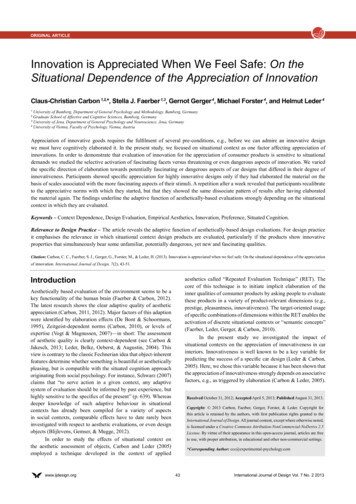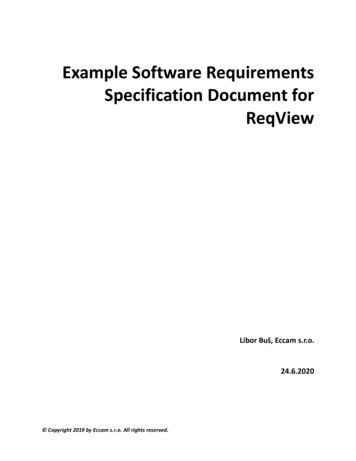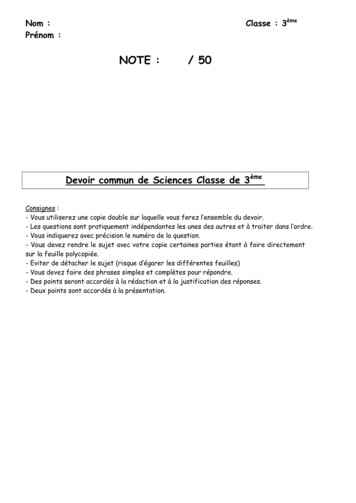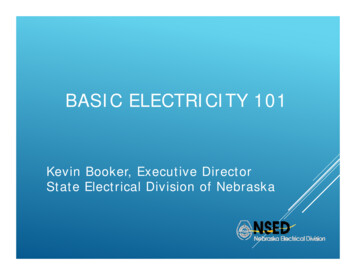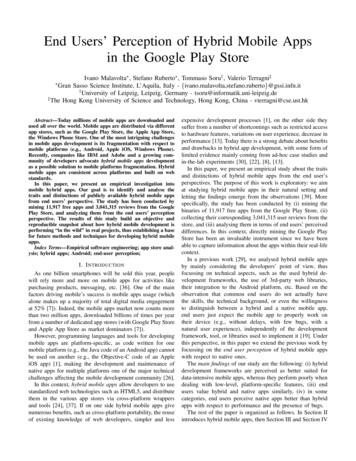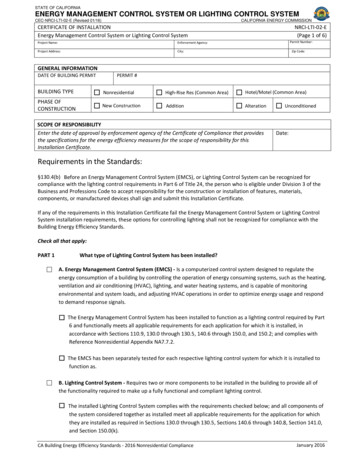
Transcription
STATE OF CALIFORNIAENERGY MANAGEMENT CONTROL SYSTEM OR LIGHTING CONTROL SYSTEMCEC-NRCI-LTI-02-E (Revised 01/16)CALIFORNIA ENERGY COMMISSIONCERTIFICATE OF INSTALLATIONEnergy Management Control System or Lighting Control SystemProject Name:Enforcement Agency:Project Address:City:NRCI-LTI-02-E(Page 1 of 6)Permit Number:Zip Code:GENERAL INFORMATIONDATE OF BUILDING PERMITPERMIT #BUILDING TYPENonresidentialHigh-Rise Res (Common Area)Hotel/Motel (Common Area)PHASE OFCONSTRUCTIONNew ConstructionAdditionAlterationSCOPE OF RESPONSIBILITYEnter the date of approval by enforcement agency of the Certificate of Compliance that providesthe specifications for the energy efficiency measures for the scope of responsibility for thisInstallation Certificate.UnconditionedDate:Requirements in the Standards:§130.4(b) Before an Energy Management Control System (EMCS), or Lighting Control System can be recognized forcompliance with the lighting control requirements in Part 6 of Title 24, the person who is eligible under Division 3 of theBusiness and Professions Code to accept responsibility for the construction or installation of features, materials,components, or manufactured devices shall sign and submit this Installation Certificate.If any of the requirements in this Installation Certificate fail the Energy Management Control System or Lighting ControlSystem installation requirements, these options for controlling lighting shall not be recognized for compliance with theBuilding Energy Efficiency Standards.Check all that apply:PART 1What type of Lighting Control System has been installed?A. Energy Management Control System (EMCS) - Is a computerized control system designed to regulate theenergy consumption of a building by controlling the operation of energy consuming systems, such as the heating,ventilation and air conditioning (HVAC), lighting, and water heating systems, and is capable of monitoringenvironmental and system loads, and adjusting HVAC operations in order to optimize energy usage and respondto demand response signals.The Energy Management Control System has been installed to function as a lighting control required by Part6 and functionally meets all applicable requirements for each application for which it is installed, inaccordance with Sections 110.9, 130.0 through 130.5, 140.6 through 150.0, and 150.2; and complies withReference Nonresidential Appendix NA7.7.2.The EMCS has been separately tested for each respective lighting control system for which it is installed tofunction as.B. Lighting Control System - Requires two or more components to be installed in the building to provide all ofthe functionality required to make up a fully functional and compliant lighting control.The installed Lighting Control System complies with the requirements checked below; and all components ofthe system considered together as installed meet all applicable requirements for the application for whichthey are installed as required in Sections 130.0 through 130.5, Sections 140.6 through 140.8, Section 141.0,and Section 150.0(k).CA Building Energy Efficiency Standards - 2016 Nonresidential ComplianceJanuary 2016
STATE OF CALIFORNIAENERGY MANAGEMENT CONTROL SYSTEM OR LIGHTING CONTROL SYSTEMCEC-NRCI-LTI-02-E (Revised 01/16)CALIFORNIA ENERGY COMMISSIONCERTIFICATE OF INSTALLATIONEnergy Management Control System or Lighting Control SystemNRCI-LTI-02-E(Page 2 of 6)Project Name:Enforcement Agency:Permit Number:Project Address:City:Zip Code:PART 2 Lighting Control Functional requirements: Check all that apply when verifying the installation of an EMCS orLighting Control System.A. All lighting controls and equipment have been installed in accordance with the manufacturer's instructions.B. The manufacturer has provided instructions for calibration.C. If indicator lights are integral to any components, such indicator lights consumes no more than 1 watt ofpower per indicator light.D. Components that are regulated by the Title 20 Appliance Efficiency Regulations have been certified to theEnergy Commission.E. The EMCS or Lighting Control System functions as one or more of the Time-Switch Lighting Controls checkedbelow, and complies with all of the following requirements:1. Automatic Time-Switch Controls meeting all requirements for Automatic Time Switch Control devices inthe Title 20 Appliance Efficiency Regulations, including the requirements below:a.b.Residential automatic time-switch controls have program backup capabilities that prevent theloss of the device’s schedule for at least 7 days, and the device’s date and time for at least 72hours if power is interrupted.Commercial automatic time-switch controls meet the following requirements:i.ii.iii.Has program backup capabilities that prevent the loss of the device’s schedule for at least7 days, and the device’s date and time for at least 72 hours if power is interrupted;Is capable of providing manual override to each connected load and shall resume normallyscheduled operation after manual override is initiated within 2 hours for each connectedload; andIncorporates an automatic holiday shutoff feature that turns off all connected loads for atleast 24 hours and then resumes normally scheduled operation.2. Astronomical Time-Switch Controls meeting all requirements for Astronomical Time-Switch Controldevices in the Title 20 Appliance Efficiency Regulations, including the requirements below:a.b.c.d.e.Meets the requirements of an automatic time-switch control;Has sunrise and sunset prediction accuracy within plus-or-minus 15 minutes and timekeepingaccuracy within 5 minutes per year;Is capable of displaying date, current time, sunrise time, sunset time, and switching times foreach step during programming;Has an automatic daylight savings time adjustment; andHas the ability to independently offset the on and off for each channel by at least 99 minutesbefore and after sunrise or sunset.3. Multi-Level Astronomical Time-Switch Controls, in addition to meeting all of the requirements forAstronomical Time-Switch Controls, includes at least 2 separately programmable steps per zone.F. The EMCS or Lighting Control System functions as one or more of the Daylighting Controls listed below:CA Building Energy Efficiency Standards - 2016 Nonresidential ComplianceJanuary 2016
STATE OF CALIFORNIAENERGY MANAGEMENT CONTROL SYSTEM OR LIGHTING CONTROL SYSTEMCEC-NRCI-LTI-02-E (Revised 01/16)CALIFORNIA ENERGY COMMISSIONCERTIFICATE OF INSTALLATIONEnergy Management Control System or Lighting Control SystemProject Name:Enforcement Agency:Project Address:City:NRCI-LTI-02-E(Page 3 of 6)Permit Number:Zip Code:1. Automatic Daylight Controls meet all requirements for Automatic Daylight Control devices in the Title 20Appliance Efficiency Regulations, including the following:a. Is capable of reducing the power consumption in response to measured daylight either directly orby sending and receiving signals;b. If the system includes a dimmer, complies with the Dimmer Control device requirements in theTitle 20 Appliance Efficiency Regulations.c. Automatically return to its most recent time delay settings within 60 minutes when put incalibration mode;d. Has a set point control that easily distinguishes settings to within 10% of full scaleadjustment;e. Has a light sensor that has a linear response within 5% accuracy over the range ofilluminance measured by the light sensor;f. Has a light sensor that is physically separated from where the calibration adjustments are made,or is capable of being calibrated in a manner that the person initiating the calibration is remotefrom the sensor during calibration to avoid influencing calibration accuracy; andg. Complies with the Title 20 requirements for photo controls if the system contains a photo controlcomponent.2. Photo Controls meet all requirements for Photo Control devices in the Title 20 Appliance EfficiencyRegulations, including the following that it does not have a mechanical device that permits disabling of thecontrol.G. The EMCS or Lighting Control System functions as a Dimmer and meets all requirements for a Dimmer Controldevice in the Title 20 Appliance Efficiency Regulations, including the following:1. Is capable of reducing power consumption by a minimum of 65% when the dimmer is at its lowestlevel;2. Includes an off position which produces a zero lumen output; and3. Does not consume more than 1 watt per lighting dimmer switch leg when in the off position.4. Dimmer controls that can directly control lamps provide electrical outputs to lamps for reduced flickeroperation through the dimming range so that the light output has an amplitude modulation of less than30% for frequencies less than 200 Hz without causing premature lamp failure.5. If designed for use in three way circuits is capable of turning lights off, and to the level set by thedimmer if the lights are off.H. The EMCS or Lighting Control System meets the following requirements:1. Is capable of automatically turning off controlled lights in the area no more than 30 minutes after thearea has been vacated;2. Allows all lights to be manually turned off regardless of the status of occupancy; and3. Has a visible status signal that indicates that the device is operating properly, or that it has failed ormalfunctioned. The visible status signal may have an override switch that turns off the signal.4. All occupant sensing devices that utilize ultrasonic radiation for detection of occupants meet theUltrasound Maximum Decibel Values in the Title 20 Appliance Efficiency Regulations5. All occupant sensing devices that utilize microwave radiation for detection of occupants meet theradiation requirements in the Title 20 Appliance Efficiency Regulations6. Occupant sensing devices incorporating dimming comply with the requirements for dimmer controls inthe Title 20 Appliance Efficiency RegulationsCA Building Energy Efficiency Standards - 2016 Nonresidential ComplianceJanuary 2016
STATE OF CALIFORNIAENERGY MANAGEMENT CONTROL SYSTEM OR LIGHTING CONTROL SYSTEMCEC-NRCI-LTI-02-E (Revised 01/16)CALIFORNIA ENERGY COMMISSIONCERTIFICATE OF INSTALLATIONEnergy Management Control System or Lighting Control SystemProject Name:Enforcement Agency:Project Address:City:7.NRCI-LTI-02-E(Page 4 of 6)Permit Number:Zip Code:The EMCS or Lighting Control System functions as one or more of the Occupant Sensing ControlsChecked Below:a. Occupant Sensors meeting all applicable requirements for Occupant Sensor Control devices inthe Title 20 Appliance Efficiency Regulations.b. Motion Sensors meeting all applicable requirements for Motion Sensor Controls devices in theTitle 20 Appliance Efficiency Regulations, including that motion sensors are rated for outdoor use.c. Vacancy Sensors meeting all applicable requirements for Vacancy Sensor Controls devices inthe Title 20 Appliance Efficiency Regulations, including the following:i.Does not turn on lighting automatically and does not incorporate DIP switches, or othermanual means, for conversion between manual and automatic functionality;ii.Has a grace period of no more than 30 seconds and no less than 15 seconds to turn onlighting automatically after the sensor has timed out; andiii.Does not have an override switch that disables the sensor.d. Partial-ON Sensors meeting all applicable requirements for partial on sensing devices in theTitle 20 Appliance Efficiency Regulations, including the following:i.Has two poles each with automatic-off functionality;ii.Has one pole that is manual-on and does not incorporate DIP switches, or other manualmeans, for conversion between manual and automatic functionality; andiii.Has one pole that is automatic-on and is not be capable of conversion by the user tomanual-on functionality.e. Partial-OFF Sensors meet all applicable requirements for partial off sensing devices in the Title20 Appliance Efficiency Regulations, including the following:i.Has two poles;ii.Has one pole that is manual-on and manual off; andiii.Has one pole that is automatic-on and automatic-off and is not capable of conversion bythe user to manual-on only functionality.f. Occupant Sensing Control systems consist of a combination of single or multi-level Occupant,Motion, or Vacancy Sensor Controls, and all components installed to comply with manual-onrequirements are not capable of conversion by the user from manual-on to automatic-onfunctionality.CA Building Energy Efficiency Standards - 2016 Nonresidential ComplianceJanuary 2016
STATE OF CALIFORNIAENERGY MANAGEMENT CONTROL SYSTEM OR LIGHTING CONTROL SYSTEMCEC-NRCI-LTI-02-E (Revised 01/16)CALIFORNIA ENERGY COMMISSIONCERTIFICATE OF INSTALLATIONEnergy Management Control System or Lighting Control SystemProject Name:Enforcement Agency:Project Address:City:NRCI-LTI-02-E(Page 5 of 6)Permit Number:Zip Code:PART 3 Requirements for which the control is being installed to complied with:Identify all requirements in the Standards for which the EMCS or Lighting Control System is installed to function as andcomplies with:Check all that are applicableA. Section 130.1(a) Area Controls.B. Section 130.1(b) Multi-Level Lighting ControlsC. Section 130.1 (c) Shut-OFF ControlsD. Section 130.1 (d) Automatic Daylighting Controls.E. Section 130.1 (e) Demand Responsive Controls.F. Section 130.5 (d) Circuit Controls for 120-Volt Receptacles.If installed to qualify for a Power Adjustment Factor, submit this Installation Certificate in addition to the PAFInstallation Certificate.G. To qualify for the PAF for a Partial-ON Occupant Sensing Control in TABLE 140.6-A.H. To qualify for the PAF for an occupant sensing control controlling the general lighting in large open plan officeareas above workstations, in accordance with TABLE 140.6-AI. To qualify for the PAF for a Manual Dimming System PAF or a Multiscene Programmable Dimming System PAF inTABLE 140.6-AJ. To qualify for the PAF for a Demand Responsive Control in TABLE 140.6-AK. To qualify for the PAF for Combined Manual Dimming plus Partial-ON Occupant Sensing Control in TABLE 140.6-ACA Building Energy Efficiency Standards - 2016 Nonresidential ComplianceJanuary 2016
STATE OF CALIFORNIAENERGY MANAGEMENT CONTROL SYSTEM OR LIGHTING CONTROL SYSTEMCEC-NRCI-LTI-02-E (Revised 01/16)CALIFORNIA ENERGY COMMISSIONCERTIFICATE OF INSTALLATIONEnergy Management Control System or Lighting Control SystemProject Name:Enforcement Agency:Project Address:City:NRCI-LTI-02-E(Page 6 of 6)Permit Number:Zip Code:DOCUMENTATION AUTHOR'S DECLARATION STATEMENT1. I certify that this Certificate of Installation documentation is accurate and complete.Documentation Author Name:Documentation Author Signature:Documentation Author Company Name:Date Signed:Address:CEA Certification Identification (If applicable):City/State/Zip:Phone:RESPONSIBLE PERSON'S DECLARATION STATEMENTI certify the following under penalty of perjury, under the laws of the State of California:1. The information provided on this Certificate of Installation is true and correct.2. I am eligible under Division 3 of the Business and Professions Code in the applicable classification to accept responsibility for thesystem design, construction, or installation of features, materials, components, or manufactured devices for the scope of workidentified on this Certificate of Installation and attest to the declarations in this statement (responsible builder/installer),otherwise I am an authorized representative of the responsible builder/installer.3. The constructed or installed features, materials, components or manufactured devices (the installation) identified on thisCertificate of Installation conforms to all applicable codes and regulations, and the installation conforms to the requirementsgiven on the plans and specifications approved by the enforcement agency.4. I reviewed a copy of the Certificate of Compliance approved by the enforcement agency that identifies the specific requirementsfor the scope of construction or installation identified on this Certificate of Installation, and I have ensured that the requirementsthat apply to the construction or installation have been met.5. I will ensure that a completed signed copy of this Certificate of Installation shall be posted, or made available with the buildingpermit(s) issued for the building, and made available to the enforcement agency for all applicable inspections. I understand that acompleted signed copy of this Certificate of Installation is required to be included with the documentation the builder provides tothe building owner at occupancy.Responsible Builder/Installer Name:Responsible Builder/Installer Signature:Company Name: (Installing Subcontractor or General Contractor orBuilder/Owner)Position With Company (Title):Address:CSLB License:City/State/Zip:PhoneCA Building Energy Efficiency Standards - 2016 Nonresidential ComplianceDate Signed:January 2016
CEC-NRCI-LTI-02-E (Revised 01/16) CALIFORNIA ENERGY COMMISSION CERTIFICATE OF INSTALLATION NRCI-LTI-02-E Energy Management Control System or Lighting Control System (Page 1 of 6) Project Name: Enforcement Agency: Permit Number: Project Address: City: Zip Code:

